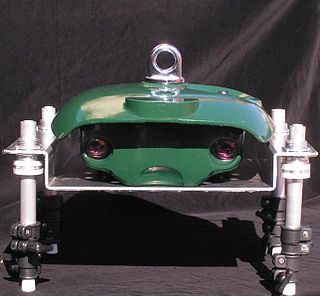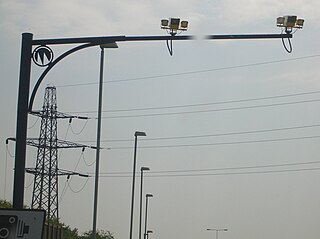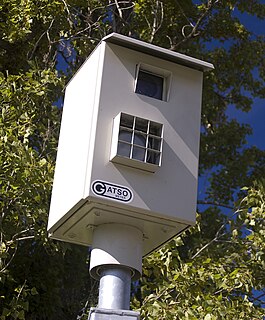
Traffic on roads consists of road users including pedestrians, ridden or herded animals, vehicles, streetcars, buses and other conveyances, either singly or together, while using the public way for purposes of travel. Traffic laws are the laws which govern traffic and regulate vehicles, while rules of the road are both the laws and the informal rules that may have developed over time to facilitate the orderly and timely flow of traffic.

Boulevard Périphérique, sometimes called Périph', is a controlled-access dual-carriageway ring road in Paris, France. With a few exceptions, it is situated along Paris's administrative limit.

An intelligent transportation system (ITS) is an advanced application which aims to provide innovative services relating to different modes of transport and traffic management and enable users to be better informed and make safer, more coordinated, and 'smarter' use of transport networks.

A traffic enforcement camera is a camera which may be mounted beside or over a road or installed in an enforcement vehicle to detect motoring offenses, including speeding, vehicles going through a red traffic light, vehicles going through a toll booth without paying, unauthorized use of a bus lane, or for recording vehicles inside a congestion charge area. It may be linked to an automated ticketing system.

Traffic calming uses physical design and other measures to improve safety for motorists, pedestrians and cyclists. It has become a tool to combat speeding and other unsafe behaviours of drivers in the neighbourhoods. It aims to encourage safer, more responsible driving and potentially reduce traffic flow. Urban planners and traffic engineers have many strategies for traffic calming, including narrowed roads and speed humps. Such measures are common in Australia and Europe, but less so in North America. Traffic calming is a calque of the German word Verkehrsberuhigung – the term's first published use in English was in 1985 by Carmen Hass-Klau.

Cruise control is a system that automatically controls the speed of a motor vehicle. The system is a servomechanism that takes over the throttle of the car to maintain a steady speed as set by the driver.

Electronic toll collection (ETC) is a wireless system to automatically collect the usage fee or toll charged to vehicles using toll roads, HOV lanes, toll bridges, and toll tunnels. It is a faster alternative which is replacing toll booths, where vehicles must stop and the driver manually pays the toll with cash or a card. In most systems, vehicles using the system are equipped with an automated radio transponder device. When the vehicle passes a roadside toll reader device, a radio signal from the reader triggers the transponder, which transmits back an identifying number which registers the vehicle's use of the road, and an electronic payment system charges the user the toll. A major advantage is the driver does not have to stop, reducing traffic delays. Electronic tolling is cheaper than a staffed toll booth, reducing transaction costs for government or private road owners. The ease of varying the amount of the toll makes it easy to implement road congestion pricing, including for high-occupancy lanes, toll lanes that bypass congestion, and city-wide congestion charges. The payment system usually requires users to sign up in advance and load money into a declining-balance account, which is debited each time they pass a toll point.

A variable-message sign, often abbreviated VMS, CMS, or DMS, and in the UK known as a matrix sign, is an electronic traffic sign often used on roadways to give travellers information about special events. Such signs warn of traffic congestion, accidents, incidents such as terrorist attacks, AMBER/Silver/Blue Alerts, roadwork zones, or speed limits on a specific highway segment. In urban areas, VMS are used within parking guidance and information systems to guide drivers to available car parking spaces. They may also ask vehicles to take alternative routes, limit travel speed, warn of duration and location of the incidents, or just inform of the traffic conditions.

A radar speed gun is a device used to measure the speed of moving objects. It is used in law-enforcement to measure the speed of moving vehicles and is often used in professional spectator sport, for things such as the measurement of bowling speeds in cricket, speed of pitched baseball, athletes and tennis serves.

Gatso is the brand that Gatsometer BV use on their speed cameras and red light cameras. The most commonly encountered Gatso speed cameras emit radar beams to measure the speed of a passing vehicle. If it is travelling above the preset trigger speed, one or two photographs are taken. These use a powerful flash, to show the rear of the vehicle, its registration plate, and calibration lines on the road. Newer installations used digital cameras which have limited exposure latitude compared to wet film, these installations use an auxiliary flash placed close to the position where a speeding vehicle would exit the radar beam and the first photograph would be taken.

Automatic number-plate recognition is a technology that uses optical character recognition on images to read vehicle registration plates to create vehicle location data. It can use existing closed-circuit television, road-rule enforcement cameras, or cameras specifically designed for the task. ANPR is used by police forces around the world for law enforcement purposes, including to check if a vehicle is registered or licensed. It is also used for electronic toll collection on pay-per-use roads and as a method of cataloguing the movements of traffic, for example by highways agencies.

The Infra-Red Traffic Logger, more commonly known simply by the acronym TIRTL, is a multi-purpose traffic sensor that can be used as a traffic counter, speed sensor, red light camera sensor, heavy vehicle tracker, overheight vehicle sensor, rail crossing sensor and network management system. The initial development of the device started in 1997 in conjunction with the New South Wales Roads and Traffic Authority & started commercial domestic and international sales in 2002. It is currently in use in sixteen countries.
Many countries have adopted a penalty point or demerit point system under which a person’s driving license is cancelled or suspended based on the number of points accumulated by them over a period of time because of the traffic offences or infringements committed by them in that period. The demerit points schemes of each jurisdiction varies. These demerit schemes are usually in addition to fines or other penalties which may be imposed for a particular offence or infringement, or after a prescribed number of points have been accumulated.

SPECS is an average speed measuring speed camera system introduced in 1999. It is one of the systems used for speed limit enforcement in the United Kingdom.
A road policing unit (RPU) is the motorway and trunk-road police unit of a British police force.

Vehicle Safety Technology (VST) in the automotive industry refers to the special technology developed to ensure the safety and security of automobiles and their passengers. The term encompasses a broad umbrella of projects and devices within the automotive world. Notable examples of VST include geo-fencing capabilities, remote speed sensing, theft deterrence, damage mitigation, vehicle-to-vehicle communication, and car-to-computer communication devices which use GPS tracking.
Driving in the United Kingdom is governed by various legal powers and in some cases is subject to the passing of a driving test. The government produces a Highway Code that details the requirements for all road users, including drivers. Unlike most other countries in the world, the UK traffic drives on the left.

Active traffic management is a method of increasing peak capacity and smoothing traffic flows on busy major highways. Techniques include variable speed limits, hard-shoulder running and ramp-metering controlled by overhead variable message signs. It has been implemented in several countries, including Germany, the United Kingdom and the United States.

Speed limit enforcement is the effort made by appropriately empowered authorities to improve driver compliance with speed limits. Methods used include roadside speed traps set up and operated by the police and automated roadside 'speed camera' systems, which may incorporate the use of an automatic number plate recognition system. Traditionally, police officers used stopwatches to measure the time taken for a vehicle to cover a known distance. More recently, radar guns and automated in-vehicle systems have come into use.

Road speed limit enforcement in the United Kingdom is the action taken by appropriately empowered authorities to attempt to persuade road vehicle users to comply with the speed limits in force on the UK's roads. Methods used include those for detection and prosecution of contraventions such as roadside fixed speed cameras, average speed cameras, and police-operated LIDAR speed guns or older radar speed guns. Vehicle activated signs and Community Speed Watch schemes are used to encourage compliance. Some classes of vehicles are fitted with speed limiters and intelligent speed adaptation is being trialled in some places on a voluntary basis.














